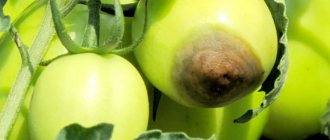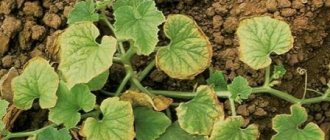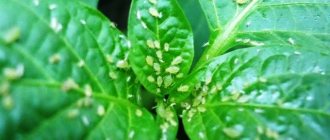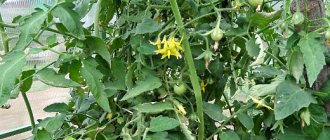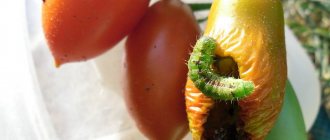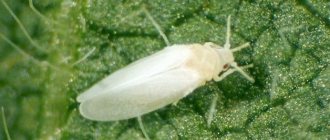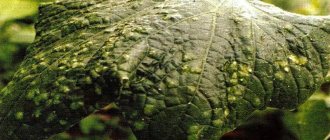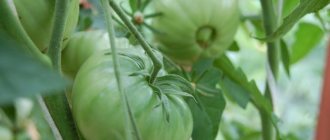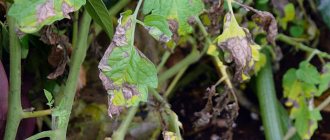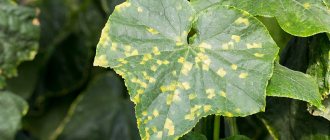Biology of the gray mold pathogen
The disease is caused by a fungus of the species Botrytis cinerea Pers, which belongs to the biological group of saprophytes. It develops in the presence of air (aerobic), temperatures from +3°C to +42°C with a humidity of 100%. It forms mycelium (mycelium), conidia, and also, under unfavorable conditions, sclerotia. Sclerotia retain the ability to germinate even after 2-3 years.
The fungus persists on plant residues, seeds, and root crops; it spreads by air, as well as with drops of water when caring for plants. The infection affects a wide variety of plants (up to 200 species, including ornamental crops), and the rate of spread of the fungus is very high.
The second name for gray rot is kagatnaya, from the word “kagat” - heap. The thing is that often the fungus affects vegetables and fruits that have already been collected and placed in heaps, turning the crop into a cluster of gray moldy mass.
Causes of the disease
Gray rot causes serious damage to tomatoes in a greenhouse. Factors that can cause infections are the following:
- Incorrect temperature. High humidity and heat are the best conditions for pathogen development. The fungus also appears in cool, damp weather, quickly affecting tomato bushes.
- Excessive watering of tomatoes.
- Excess nitrogen fertilizers in the soil.
- Pests on tomatoes: aphids, thrips. Plants that are weakened and damaged by pests are more often affected by the fungus.
- Thickened plantings of tomatoes.
- Lack of disinfection of the greenhouse after harvesting.
- Use for planting infected seeds.
- Failure to observe crop rotation on the site.
The fungus persists on plant residues after harvesting, in the soil, and if proper prevention is not carried out (disinfection of soil, shelters, equipment), and if tops and leaves from garden crops are not removed on time, then there is a high risk of a dangerous infection appearing on the site.
On a note! In addition to tomatoes, black rot affects strawberries, potatoes, beets, radishes, cucumbers, and onions.
Tomatoes pick up infection from infected crops, and plants also become sick when planted in beds where cucumbers or lettuce infected with the fungus previously grew.
Causes of blossom end rot in tomatoes
Experts identify several reasons why tomatoes suffer from blossom end rot:
- insufficient amounts of moisture at high temperatures;
- alternation of waterlogging and lack of moisture;
- irregularity of moisture;
- no loosening;
- planting in light soil, which is dominated by sand;
- poor soil permeability;
- oversaturation or deficiency of calcium in the soil;
- excessive nitrogen content;
- soil salinity;
- uncontrolled application of fertilizers.
Symptoms of gray rot
The first sign of plant damage by the dangerous fungus Botrytis cinerea Pers is the appearance of grayish spots similar to ash dust. At first (5-6 days) there are no spores on the spots, the spots increase in size. Most often they appear near places where leaves and shoots were torn off.
After a week, the spots lighten, and the stem is surrounded by light brown stripes. Inside the stem in this place, the blood vessels die off, so the leaves above turn yellow and dry out. Later, after about 10-12 days, a gray coating is observed on the spots (they become terry), which indicates the appearance of pathogen conidia. Then the infected areas soften and die.
The infection spreads from shoots to flowers and fruits, gradually affecting the entire plant. The disease spreads throughout the greenhouse and without timely protection and measures, most of the tomato bushes die.
Signs characteristic of the disease
On infected bushes, grayish-brown spots appear with an ashy coating. Spreading along the stem after three to five days up to 5 cm, the spot covers the perimeter of the stem. During the first week, there is no sporulation of the fungus of this disease.
Necrosis of blood vessels and bark grows inside the stem. Due to the lack of water flow on a small part of the stem, necrosis causes the tomatoes to wilt. Foliage placed above this area begins to turn yellow, and many airy formations form on the stem.
During the process of infection of the plant, only part of it, directly above the spot that appears, withers. After a week, a gray coating forms along the edges of the spots. In the event of excessive air humidity and in the presence of rain, flowers and fruits are also infected, on which spots appear that resemble a circle. Read also the article: → “Why do tomato leaves curl in a greenhouse?”
Effective agricultural techniques in the fight against gray mold
Gardeners have accumulated extensive experience in combating dangerous infections, but experts say that it is easier to prevent any disease than to treat it later. Therefore, first of all, it is important to follow tomato agricultural technology.
- Tomatoes love abundant, infrequent watering, but cannot tolerate high humidity. Therefore, after watering, it is necessary to ventilate the greenhouse by opening the windows and doors.
- Loosening the soil after watering is another indispensable condition when growing tomatoes. If there is no time left for this, then it is useful to mulch the soil with hay, peat, and humus.
- Tomato is a crop that needs plant formation. Pinching and removing leaves are mandatory agricultural practices for most varieties and hybrids. The wounds formed during cuts are a hotbed for infection, so all operations are carried out carefully, in the morning, using disinfected sharp knives or scissors. During the day in dry weather, the wounds heal and dangerous pathogens will not get into them.
- All trimmed leaves and tomato shoots are removed from the greenhouse. There should be no weeds or plant residues on the beds.
- Water the tomato bushes at the root, preferably in special grooves or holes.
Important! Moisture should not get on the leaves, flowers and fruits of plants.
- When fertilizing, you should also not allow fertilizer compounds to come into contact with the plants. This causes burns and various defects on leaves and shoots, which leads to weakening of tomatoes and increases the risk of Botrytis cinerea Pers.
- Every year they change the place for planting tomatoes, returning them to their original place no earlier than after 3-4 years. If this is not possible, then in the fall the greenhouse is disinfected, the top layer of soil on the ridges is removed and replaced with a new one. In the spring, it is recommended to plant green manure in front of the tomatoes and water the soil with a solution of potassium permanganate (to disinfect the soil).
- Planting tagetes (marigolds), calendula (marigolds), and mustard has a good effect on improving soil health. These plants secrete special substances that have a detrimental effect on the spores of the gray mold fungus.
- When planting, use only healthy seed material. When collecting your own seeds, disinfection with a solution of potassium permanganate is mandatory before sowing seedlings. When planting seedlings, follow the recommendations regarding the distance between plants. Thickened planting of indeterminate tomatoes in a greenhouse is not allowed. This leads not only to a lack of nutrients, but also to the emergence of numerous diseases.
- For irrigation, it is recommended to install drip irrigation systems in greenhouses.
- No tomatoes have been developed that are completely resistant to gray rot infection. But the hybrids Pilgrim F1 and Vasilyevna F1 have proven themselves to be resistant plants, less susceptible to dangerous fungi than other tomatoes.
Tilling the soil after infected tomatoes
After treating damaged plants, it is also necessary to treat the area to avoid re-infestation.
- Destroy all remnants.
Considering that black sclerotia of fungal spores accumulate in plant debris by the end of the growing season, they must be harvested carefully and completely disposed of. Plant residues showing signs of disease should not be used in compost heaps.
- Land cultivation.
Includes fumigation of soils, substrates for greenhouses, steaming of soils. To disinfect the soil, the soil is spilled with a solution of one of the drugs (Alirin, Glyokladin, Barrier and others), which have a detrimental effect on surviving fungal spores.
- Deep plowing.
In autumn, after removing plant residues and disinfecting the soil, dolomite flour or chalk is added and the soil is dug deep.
In protected ground, it is mandatory to disinfect structures, glazing, tools and materials. Fumigation can be used by burning sulfur briquettes.
The use of biological agents in the fight against gray mold
In order to contain and prevent the appearance of secondary foci of the disease, the following agents are used on tomatoes:
- Trichodermin;
- Glyocladin.
The methods are labor-intensive, but the use of drugs gives a long-lasting effect.
Trichodermin
The preparation is based on bioactive substances secreted by beneficial soil fungi Trichoderma sp. Trichodermin is used against a number of fungal diseases, including gray rot.
Available in the form of an aqueous suspension or dry powder. The product must be used at temperatures above +14°C, since spore activity occurs at such temperatures.
Application
- A Trichodermin suspension is applied to the affected areas of the plant.
- After cutting stepsons or leaves, it is recommended to lubricate the wounds with a suspension of the drug for preventive purposes.
- Spraying tomatoes with an aqueous suspension.
A composition is prepared for spraying: 100 ml of the drug is diluted in a bucket of water.
On a note! Chlorinated water is not suitable for preparing the composition, since chlorine kills beneficial fungal spores.
Tomatoes are processed in the morning so that the plants have time to dry before nightfall.
Glyocladin
The drug is based on the fungus Trichoderma harzianum VIZR-18, which penetrates the colonies and sclerotia of pathogens and destroys them.
The drug does not accumulate in soil or plant tissues, and is safe for people and animals. To process tomatoes, use powder, which is diluted in water (50 grams of product per liter).
Both drugs are effective in the early stages of gray rot, but if the disease has spread to many plants, it is necessary to promptly apply chemicals.
Gardeners practice treating plants with sodium humate (a growth regulator), which prevents the appearance of a dangerous fungus on tomatoes.
How to fight the disease in a greenhouse and in open ground
- We process the seedlings.
Good preventative agents against gray rot, which are sprayed before planting, are:
- infusion of garlic (you can shoot it), for which 30 g of chopped garlic are infused in 10 liters of water for 2 days;
- 0.5 percent solution of Bordeaux mixture.
- In the greenhouse.
Maintaining low humidity, optimal temperature and regular ventilation in the greenhouse is the main part of preventive measures against gray rot. For prevention, treatment is carried out with a solution of Trichodermin suspension.
When identifying foci of disease, pastes with fungicides and treatment of plants with chemicals are used.
- In open ground.
Treatment with sodium humate and Trichodermin suspension after removing leaves, shoots and weeping spots will help reduce the risk of the spread of gray mold diseases by one and a half to two times.
You can see what gray rot looks like on tomatoes and learn about the possible causes of its appearance from the video.
Chemicals to combat gray mold
Fungicides are used to coat plants damaged by the gray rot fungus, and continuous spraying is used only in case of massive lesions of tomatoes.
For minor infections, it is permissible to use the following compounds:
- Ditan M-45;
- Bordeaux mixture;
- Profit;
- Integral;
- Speed;
- Fundazol.
Treating tomatoes with Hom, Oksikh, and Abiga-Pik gives a good effect.
To destroy pathogenic fungi, the drug Euparen is used. This is a contact fungicide, available in powder form. The drug is based on dichlorofuanide, which has a detrimental effect on fungal sporulation.
The drug is diluted in water (a 2% solution is used on tomatoes), following the dosage according to the instructions.
Of the systemic contact agents on tomatoes, the use of Ordan, Previkur, Acrobat MC is shown.
To coat plants (stems, leaves) affected by gray mold, use a special paste mixture.
Pasta recipe:
- 300 grams of CMC glue;
- 30 grams of any fungicide;
- a bucket of water.
The glue and fungicide are mixed in water until completely dissolved, then chalk is added to form a paste. Apply the mixture to the spots, while also including healthy tissue around the affected area. After 10-12 days, the coating is repeated.
Folk remedies
To combat infection, folk remedies are used, among which the most effective are:
- soap solution (spraying tomatoes with a solution of green garden soap);
- boric acid (treating plants with a 1% solution of the product);
- baking soda (take 80 grams of soda per bucket of water, thoroughly dissolve and treat the affected bushes).
Such compositions help cure tomatoes only if the infection is noticed at an early stage and there is no major damage.
Tomato varieties resistant to blossom end rot
Breeders have developed a number of varieties that are characterized by resistance to this disease.
Therefore, if a gardener has had a sad experience of dealing with a disease or does not want to face the problem, he needs to choose one of the following varieties for planting:
- "Leah";
- "Alpatieva";
- "Oak";
- "Astrakhan";
- "Volgogradsky";
- "Pharaoh";
- "Lunar";
- "Martha";
- "Rotor";
- "Grand Canyon".
Thus, blossom end rot is a common disease in tomatoes, which occurs due to the fact that the owner of the garden does not care for the plants enough or incorrectly. Tomato blossom end rot is treatable. However, it is important to prevent its development by carrying out correct agricultural practices and resorting to preventive measures.
Approximate scheme of preventive measures against gray rot
In order to minimize the risk of occurrence and consequences of gray rot, treatment of tomatoes and shelters where they grow must be timely.
Approximate treatment plan:
- in spring - soil treatment with special preparations Fitosporin, Glyokladin;
- early summer - coating tomato bushes if there are foci of disease on them;
- August - treatment of plants with fungicides (if gray rot appears en masse on the plantings);
- September – repeated treatment of plantings with preparations.
Important! After harvesting the fruits, it is necessary to disinfest the greenhouses, treat the soil, and replace it.
Gray rot, which is dangerous for tomatoes, can be prevented with the help of preventive measures and compliance with agricultural practices. In case of infection of plants, special preparations are used, strictly observing dosages.
